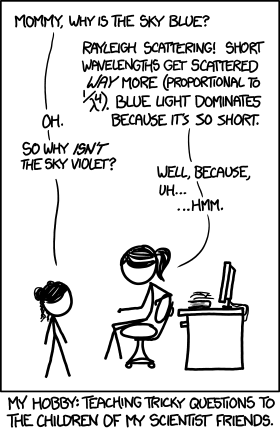Sky Color

Feynman recounted another good one upperclassmen would use on freshmen physics students: When you look at words in a mirror, how come they're reversed left to right but not top to bottom? What's special about the horizontal axis?

Feynman recounted another good one upperclassmen would use on freshmen physics students: When you look at words in a mirror, how come they're reversed left to right but not top to bottom? What's special about the horizontal axis?
The point of this comic is that often, curious children, like Jill, ask their parents simple questions about understanding how the world works. Often, although the question is simple, the answer is not. "Why is the sky blue?" is a common example, since most parents are not familiar with Rayleigh scattering, and thus are unable to answer the question.
Randall's hobby is to make those questions even harder, so that the parents who are familiar with the subject (scientists, for example) will be stumped.
Another point of this comic is that we often think that we understand a scientific phenomenon (e.g., "Why is the sky blue?"). However, a certain simple follow-up question (e.g., "Why isn't the sky violet?") can often uncover large gaps in our actual understanding.
Rayleigh scattering is the phenomenon that explains the color of the sky, where light of every wavelength gets scattered in the air by the inverse quartic (fourth power) of its wavelength as given in the comic. In the visible spectrum, blue light has a wavelength of 450–495 nm while violet has a shorter wavelength of 380–450 nm. Violet light does indeed get scattered more than blue light, however the lower portion of the spectrum for sunlight consists of blue light and eyes are much more sensitive to blue light than violet light. Furthermore, the sunlight contains more blue than violet to begin with as a result of the surface temperature of the sun. This leaves the impression of a blue sky. A good explanation, including why blue and not violet, can be found in Usenet Physics FAQ :: Why is the sky blue?, but note that human color perception is more complicated than described there. xkcd later tackles the same question in 1818: Rayleigh Scattering.
The title text refers to a mirror image and is discussed by the famous American theoretical physicist Richard Feynman in a famous BBC documentary [1], as one of the problems which he used to have fun with freshmen (in a British English context, that would be a student in their initial year of university, more commonly referred to as a "fresher", but the term may elsewhere be applied to those in the first year of other stages of education). If not for this direct quote, the apparent age of the potential student pictured, and the scientific detail of the question, could easily apply to lessons in the later years of primary education.
A mirror image is a virtual image produced by the reflection of light on a mirror. It's common to think of images in mirrors as being reversed left-to-right, as any text held in front of us will appear flipped. This is actually an issue of perception. In a plane mirror, images are reflected directly: the left side of your body will be reflected in the left side of the mirror, and vice-versa. The source of confusion is that people tend to think of a mirror image the way we would think of a person facing us. When another person faces us, they turn around the vertical axis, placing their right hand on our left side, so seeing our left hand on our left side in a reflection seems like an inversion, even though it's a direct representation. By the same token, in order to hold text up to a mirror, we generally flip it around the vertical axis, so that the start of the text is on right, and the end on the left (in English, at least). When the mirror reflects this, we see the text as backward, but the mirror hasn't reversed it, we reverse it when we turn it toward a mirror.
In other words, the vertical axis is only "special" because we're used to objects turning around it, so we come to expect that reversal, instead of a reflection.
You can induce a mirror to reverse left and right only --- by standing next to it instead of in front of it, facing along the plane of the mirror itself. If you lift your right arm, you can clearly see your image's left arm raising, without having to adjust for frame of reference. Similarly, you can induce a mirror to reverse top and bottom only by holding it flat above your head or laying it flat on the ground and standing on it (or perhaps standing under a suitably equipped bedroom ceiling). See this video for a demonstration.